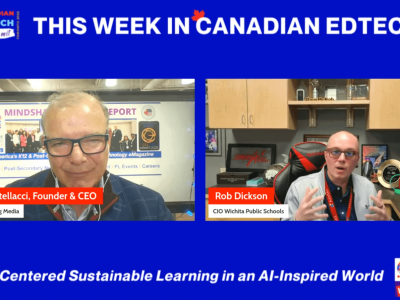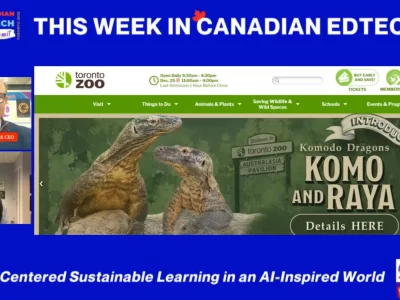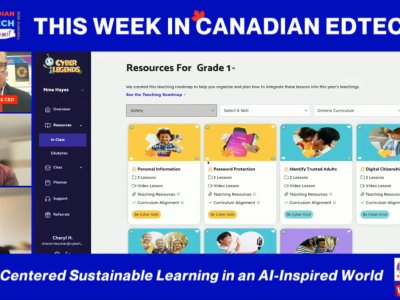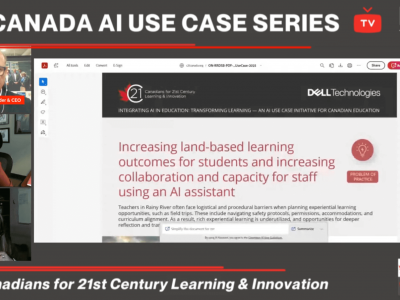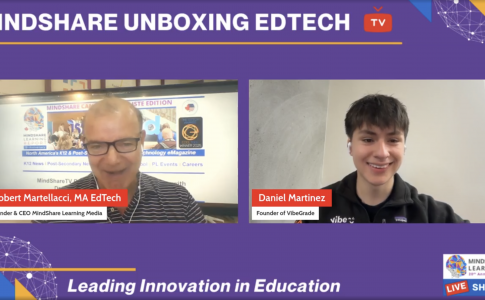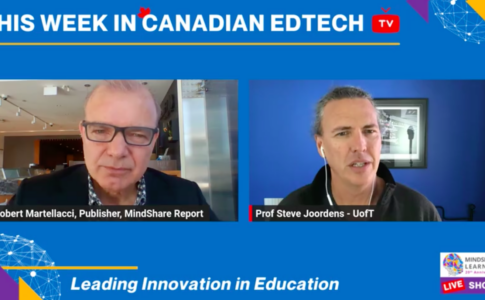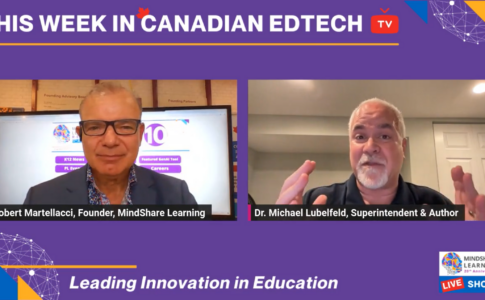By Timothy Gard, Educator, Toronto District School Board | Twitter @MindShareK12
No one would argue that Michael Fullan is committed and devoted to system change in education. His reputation as an expert in education, especially in change management and leadership, speaks for itself. His books, articles and counsel have been much sought after in a world looking for leadership when what we have known – the past imperative – has come face-to-face with the present imperative. We must change or become irrelevant. Michael Fullan in his new book entitled, Stratosphere, writes that there are three big ideas that have needed each other for four decades. Fullan calls the marriage of pedagogy with change knowledge and technology the Stratosphere.
An interesting title for this relationship to say the least, but nonetheless a valid one, I think. For those of you who haven’t taken astronomy 101 or aren’t inclined to think beyond the earth’s crust, then you’ll be happy to know that the stratosphere is one-third of our atmosphere. It rests just above the troposphere and just below the mesosphere. Fullan uses the reference loosely to indicate that this ‘stratosphere’ is beyond the clouds – a network of information that is ‘out there’ without location, and yet it can be ‘located’ with our portable devices. His intention is to create an understanding that there are things that we do not yet fully comprehend with regards to these three mysterious forces.
I applaud Michael Fullan for delving into the murky waters of technology and education; I expect that there will be an ‘interesting’ reception to his ideas but at the very least he invites the leaders in educational technology to take a less myopic look at the relationship between education and technology by linking pedagogy, change management and technology together, because they need each other and because linking them together will create a powerful synergy for moving education into a new paradigm. And in order to move forward so that this trio works together in a harmonious way we must be sure to examine and re-examine our ideas, assumptions, biases and presumptions. This book is short at only 100 pages and six chapters but it’s packed with solid academic references, which Fullan uses to support his case, and I think, powerfully.
In the first chapter he reviews the journey of education reform in a general way touching on what’s happened to education in Ontario in a subtle self-panegyric sort of way. He is however focused on change management and his goal as ever is to make change easier. He notes that technology has not had much of an impact in education reform to this point but he wonders if top-end higher order thinking skills remain stagnant because of the lack of technology usage. He thinks however that the growth of technology has been weed-like; it has grown wildly and aimlessly and has supplanted what our systems of education really need. In Fullan’s equation, pedagogy plus change management plus technology equals great gains in education because technology can be an accelerant on a large scale with minimal costs after initial investments. He also disquiets the reader with a caveat: there can be huge dangers in technology; things can get worse, not better.
Fullan addresses in this work the four criteria that need to be integrated in pedagogy and technology if we are to create exciting and innovative learning experiences for all students, which he agrees is something that is desperately needed in order to move our systems forward into the 21st Century. The following four criteria should be evident: (i) irresistibly engaging for all stakeholders; (ii) elegantly efficient and easy to use; (iii) technologically ubiquitous 24/7; and (iv) steeped in real-life problem solving. He goes on to mention that the triad of pedagogy, change management and technology, when working together in harmony is fundamentally liberating and this liberation is needed when the old, outdated school system we currently enjoy is becoming unsustainable. No argument here! Learning for all is a very real and future possibility if we embrace technology as a slave to our needs; a slave that works in cohort with pedagogy and change management so that we can create a system of education that is future-proof. Our current system is inefficient, inflexible and caters to the ‘status-quo’.
Fullan reminds us that technology can easily be used to create superficial work and to lead people on ‘causes’ that have far more disaffected and affective advantages than meaningful and productive ones. But again, no one ‘entity’ can become in and of itself insulated from ‘good’ or ‘bad’; perhaps the Internet and technology in general are mere amplifiers of a tendency already strangely inherent in all of us? This can then become ‘group think’ at higher levels where no one really knows how much information is being gathered about our living habits, both online and off. Even if we’ve read the Facebook legal fine print and have set our privacy filters ‘to the max’ is big brother still aware? Do we really know what we think we know, or are we involved in a big cosmic dupe? Perhaps as Fullan suggests that our brains are being distorted into a permanent state of hyper-distractionism. He spends a number of pages talking about the way our brains have been affected by information overload via the Internet because we’re constantly looking for a ‘fix’. These addictions are indeed cause for concern because there is the very real possibility that our ‘humanness’ is being eroded by our inability to focus on anything with any great attention to detail. We’ve become a ‘cog in the wheel’ so to speak.
Fullan quickly takes us away from the ‘doom and gloom’ of technology to what he believes is the way out of this digital quagmire. In short, the focus should come off of technology per se and on its use. Focus on what the tool can do rather than on the tool itself. What can technology do for us? Let’s reverse the trend from slave to master; humans should shape technology rather than the other way around. Fullan brings this way round to technology and education and determines that we have a long way to go. He notes, as has been noted ad nauseum by the users of technology in schools, that technology isn’t used much. Students use it far more outside of school and this use has limited merits. Fullan believes fully, as he noted in his Seminar 204 paper, that technology needs to be seen as an enhancer of education and not a driver. What can technology do for us rather than focusing on loading up our schools with technology because somehow – magically – this technology will improve learning?
According to Fullan if we can integrate the advances in pedagogy, especially around how we learn, in technology, especially with regards to engagement, in change management, especially in the way we can make things easier, we will have arrived at a powerful solution in making our future more fulfilling for everyone involved, both teachers and students. Technology can be a powerful engine for learning and change, but humans (teachers) must be the drivers.
Fullan’s next chapters deal with the essentials or the essence of the stratosphere. Chapter three focuses specifically on pedagogy and change. The ‘skinny’ as Fullan likes to state is that we must be concerned with two big things: engagement and efficiency. If the triad is properly integrated then we can produce both engagement, for both teachers and students, and high-yield with regards to what is learned. Fullan moves on to discuss what change can look like by using examples from his Ontario experiences showcasing evidence that suggests that real, personal involvement in a high school student’s life can result in positive results in his or her attitude, outlook and behaviour. This is the movement from the isolating, decontextualizing that can often happen in technology to the real, human interaction that speaks of real community, especially if that community involves a caring adult for a student who needs that positive interaction, especially those students who are at the margins of a school’s society.
This change has to happen at both the student and adult level. Every leader and teacher involved in managing complex change in his or her school environment whether a school administrator or teacher-leader knows how difficult it can be to leverage change in a context where comfortable means holding on to the old, out-dated and outmoded ways of doing education. Fullan notes that these changes are moved by small ‘wins’ where adults see their work life as more positive than negative; all people need to be aware of regular progress. We need to know that we’re moving forward and not backward.
The balance of this chapter involves a discussion of what Fullan terms ‘The New Pedagogy’. He weaves his way across a vast amount of material where he discusses topics ranging from constructivism and creativity to student and teacher engagement. A great deal of the material will not be ‘news’ to the seasoned educator; the bringing together of these ideas to form a coherent whole will be. The key point of this chapter is the focus on Clayton Christensen and Michael Raynor’s notion of disruptive innovation. We must discontinue our blind assumptions that we can improve the current product (our current education system as it is now – out-dated and outmoded). To create a new system we must engage in disruptive innovation. We often fail to take notice of this new disruptive innovation because it lacks cogency and power in the early nascent stages compared to the more mature outmoded way of doing things. This was interesting to note because the system that Fullan champions also seriously suffers from this malady.
Fullan’s concluding statements and points in this chapter are most compelling. He states that the combination of four ideas make the case for the new pedagogy as essence as easy. He notes that it is becoming clearer and clearer to most people that ‘tell and test’ do not work; partnering with students in learning will accelerate at a far greater rate because of technology; the new way of doing things will advance more quickly because it’s more naturally human because it taps into the essence of what it means to be human; and finally it’s easier because people will enjoy doing what they are doing and this will necessarily compel change because more people will be involved in something they enjoy doing. Fullan weaves this through insights gained from Marc Prensky’s work on partnering and empowering students and leveraging technology as the ‘connector’. This ‘disruptive innovation’ must be engaged and managed; we can’t let this opportunity get away from us Fullan argues.
In this chapter he ‘fleshes out’ what he means by the four criteria for integrating technology and pedagogy he mentioned earlier in the book. In brief he elucidates the criteria as follows: Irresistibly engaging is simply that state where an individual or individuals are so caught up in doing that time loses coherence; time has no meaning as he notes; by elegantly efficient he means that the products must be easy and natural to use. He conjoins the first two criteria with the third by stating that in order for the first two criteria to work we must have technology that is at our ‘finger tips’ all the time. And finally he makes the very valid point that this learning must be steeped in real-life problem solving projects where teaching leads to entrepreneurialism. Fullan argues that there is no system in the world that currently applies these four criteria. He goes on to challenge what he terms, and rightly so I think, ‘Digital Disappointments” and ‘Digital Dreaming.” Most notably he challenges the current reform movement in the United States.
For the sake of time and relevancy, we won’t go into detail about what Fullan says about the ‘to and fro’ of the American way of whole system reform. We will however note what Fullan has to say about the 21st Century skills movement. Up front he declares that these skills – 21st Century Skills – are too vague to be of any use and more importantly they leave out pedagogy. How do you get to this skill or that skill without a clear learning plan? He seriously engages the whole ‘mantra’ of 21st Century skills and hits home here in Canada by singling out Alberta’s ‘Inspiring Action on Education’ mandate as more inspiration with no perspiration. Fullan argues that from his experiences in change work action results in inspiration rather than the other way around. Fullan uses his experiences in collecting research on 21st Century learner skills and noted that the goals were too vague and that more often than even when they focused on the specifics of standards and assessment pedagogy was omitted. To make matters worse, technology was not used in learning.
Fullan carries on in this theme by stating that despite the amount of technology in the ‘world at large’ very little of it is showing up in schools. He states that fully integrating technology into classroom programs only happens in 8 percent of cases and that only a quarter of teachers feel that they could integrate technology into their classrooms. The support for making this happen is also badly underdeveloped. This is not news to us at MindShare Learning. We continue to encounter only a handful of schools and districts that have employed technology in meaningful ways where they might be considered as approaching the four criteria that Fullan mentions earlier in the book. Much of this can be seen as a serious lack of leadership and vision when it comes to utilizing the power of technology as an enhancer of teaching and learning, of embracing pedagogy and change management.
We see various reasons for this, not the least of which is because system leadership is less than adequate when it comes to harnessing technology along with pedagogy and change management – the leaders are still attached to the old paradigm because that’s all they know. Who leads the leaders? Further, there’s often no coherent plan to harness the power of technology in current pedagogical models. The reasons for this are many however we have noted that much of it can be reduced to one key problem: leadership.
Fullan’s point – again – is that we have little evidence of the impact of technology on learning. In fact, he argues technology and schooling are working at cross-purposes and this hasn’t changed for some time. We at MindShare Learning have seen exceptions to this however. From our first video contest where teachers were asked to submit short videos about technology use in the classroom we have seen some examples of solid technology integration that included sound pedagogy. What we didn’t see, and is difficult to ascertain without actually measuring independently, was the more elusive ‘change management’.
To be fair though, that particular piece of the triad is often beyond the teacher’s control. Teachers are still captives of an old framework and this old framework is not very open to new ways of doing things. Teacher-innovators who often fuel the fire of change and lead at a grassroots level the move toward a solid plan for implementing technology in pedagogically sound ways are often held captive by leaders – local and district level administrators who have not grappled with what’s going on in the ‘real world’ and so it’s typically business as usual. Who changes the change leaders here? Who better to inform the leaders then the teachers who know first-hand what students are more likely to get involved in with passion and purpose. There are exceptions to this however it merits pointing out that in order for real change to happen the leaders in the current system need to be informed and empowered.
Fullan’s section on “The Flipping of Teacher and Student Roles’ is happening but at a rate that is often unsustainable with too few resources and a lack of a cogent plan to move forward. Fullan notes the following:
“To free up all that wasted instructional time is to generate a windfall of better time use, not to mention the new time that is created by the expansion of learning to the 24-hour clock and the hordes of peers engaged in collaborative social learning. Teachers in small groups become leaders, designers, and active guides to learning. Principals become leaders of leaders (not instructional leaders). District and state infrastructures become redesigned to promote and hold schools accountable to … innovative teaching and learning.” ( Fullan, 47)
Teachers become change agents; teachers as activators rather than facilitators. Activators give feedback to students, help students access their own thinking, provide challenging goals whereas the facilitator is focused on problem-based learning, simulations and gaming, individualized instruction. The research has shown that the teacher as facilitator has a greater impact on student achievement. Fullan right notes however that we cannot make this sort of flip happen without a plan. Pedagogy and technology need to be properly aligned. Fullan goes on to mention that students and teachers need to act as teams and he uses various analogies to explain how this can and should happen. In short, we need to create the new digital learning reality on a much larger scale than is currently happening – for all students and teachers.
Of course none of this is going to happen without whole system reform and that is not going to happen without change knowledge. Up to this point in his work Fullan has not said a great deal about change knowledge, though it is definitely on the periphery of each key point he has addressed. In chapter five he addresses design principles and change knowledge. And who better to start this chapter off than to bring the late Steve Jobs into his discussion about design principles, especially for successful products. In his discussion of Jobs he draws to our attention the things that many of us already know – who hasn’t read the latest biography of Steve Jobs? Fullan however draws from Jobs ‘genius’ and extends it to education.
In short, Fullan wants us to know that education revolution is not a given. Even with Apple’s own iPad, which schools and districts are investing in on masse, we must be wary of technology that isn’t embedded in a plan using solid pedagogical principles. This kind of technology needs to be driven by strong pedagogy. Amen. The iPad wasn’t designed specifically for education; it’s a piece of hardware with innovative features but it doesn’t mean that when a student is handed an iPad – or any other device, for that matter – the student will understand how to use the device to learn – the device is really stupid, after all. How many apps are focused on the old educational paradigm?
As we move forward in this time of technological revolution several things are becoming clearer: devices and software are becoming more and more powerful and far easier to use. And as these devices become more and more powerful and ubiquitous the ‘disruptive innovation’ cycle will move from the nascent beginning stages to more mature and complete ones. This is again not a given. Leadership is necessary and leadership that is guided by the principles that Fullan has so eloquently addressed in this book. And to come against the biggest obstacles of change – inertia, skepticism, and indifference according to Fullan – we need to ensure that apart from finding the key factors in grabbing the attention of the naysayers, we also need strong, visionary leadership.
The key to change knowledge Fullan notes is all about implementation; there’s no point integrating technology and pedagogy in a new ‘product’ if there’s poor implementation. He mentions the eight key areas of change knowledge: focus, innovation, empathy, capacity building, contagion, transparency, elimination of the non-essentials and leadership. Pedagogy and technology provide the directional vision and change knowledge helps us to achieve it – we learn as we go Fullan points out. Interestingly, and I wondered about this as I perused the book, what is the place of the teacher in all of this? Of course pedagogy cannot happen without the teacher and as Fullan has mentioned the teacher needs to take on new and exciting roles as the critical change agent. As he notes, using the meta-studies of John Hattie, we know a great deal about what skills that teachers as change agents need to have:
“critical change agent skills (in order) are knowledge and skills; a plan to action; strategies to overcome setbacks; a high sense of confidence; monitoring progress; a commitment to achieve; social and environment support; and freedom, control an choice.” (Fullan, 67, and quoting John Hattie in Visible Learning)
Fullan continues to focus on the challenge of implementing his triad of pedagogy, technology and change knowledge and he’s convinced, as we are, that if we get it right educational transformation will accelerate dramatically and technology will pay for itself.
But will technology pay for itself? Fullan’s last chapter addresses this very notion by stating that we must make technology pay and if we are going to make it pay we must have a plan. This plan should properly align technology with teachers and students. This triumvirate of sorts needs to be the focal point because too many education systems have wrongly concluded that putting technology into the hands of teachers who are less than capable are fooling themselves. Amazing change agents can take technology and make amazing things happen with students – no two ways about it!
As I wrap up this review I note that Fullan addresses inequality which of course is an issue in any western country, but more specifically in the largest and most powerful one. He notes that his triad can provide a solution by uniting capital with labor and he gives ‘the skinny’ (his favourite phrase and always his focus) by stating that the solution for inequality so that people are not left behind is to make it all about the learning, let technology permeate and engage the whole system. Fullan’s experience informs his ‘list’ so that it’s simple and focused; long lists don’t work for change he notes. He also notes that we must continue to ask ourselves this question: “How do we make everything we do about learning?” Further we must let technology permeate and pedagogy should lead the technology so that human and social capital increases. He notes however that technology is not a panacea; great pedagogy exists without technology – that won’t change. But we MUST explore what technology when properly harnessed and tethered to pedagogy and change management can do for educational reform, if not societal reform.
I enjoyed reading through Fullan’s entry into the technology malaise; it was rich, fruitful and above all it showed someone wise and practical addressing key issues that are becoming ever more a part of the world of education, if not the world in general. I am concerned with the leadership quotient however; I have seen some key individuals driving this kind of system reform but I am concerned that too few are aware of the need to use the ‘stratosphere’ to move education reform to the new paradigm. More work needs to be done; more discussion needs to happen and more change leaders with clear vision, unbridled passion for change in the right direction and a unified approach that addresses our current funding issues with all key stakeholders involved will get this work done. We need to take what Michael Fullan has written and put it into practice so that our society as we now know it does not slip into a coma; a coma brought on by the ever moving machine of technology that has so pervaded our way of doing and thinking, drawing us into a brave new world that’s not so brave and not so new. Michael Fullan’s book, Stratosphere, is a must read!
Bravo, Michael Fullan! Bravo!
